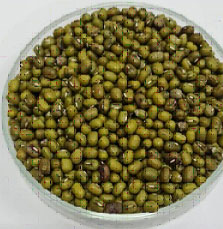Pectinase Inhibition of Protein Extracts from Vigna radiata (L.) Wilczek and Vigna mungo (L.) Hepper Seeds
Keywords:
mung bean, black gram, protein extract, pectinase, pectinase-inhibiting proteinAbstract
Bruchid (Callosobruchus maculatus F.) is one of the most problematic insects for the storage of mungbean.
The insect pest secretes pectinase to break down pectin, a polysaccharide found in plant cell walls, enabling it to infiltrate, feed on, causing damage. The differences in resistance to bruchids among mungbean varieties could be associated with the inhibitory effects of pectinase activity. Therefore, the objective of this study was to examine pectinase inhibitory activity of protein extracted from two mung bean cultivars (KPS1 and KUML3) and one black gram cultivar (CN80). Effects of testing dose and heat stability of the protein extracts on the pectinase inhibition were also evaluated. The experimental results revealed that raw seeds from the three mungbean cultivars exhibited pectinase inhibition activity. However, the black gram cultivar CN80 showed the greatest inhibitory. Pectinase inhibition activity was increased proportionally with the rising quantity of protein extracts. Moreover, it was observed that boiling for 10 minutes resulted in a decrease in the enzyme inhibition capability of all protein extracts, yet with varied degree of diminution. This experiment illustrated that the genetics of mungbeans, the quantity used, and the preparation of protein extracts all had an impact on pectinase inhibition activity. Nevertheless, it is essential to conduct studies on the specific proteins associated with pectinase inhibition activity to gain better understanding of the mechanisms of resistance against bruchids. This understanding can be applied to mungbean breeding programs for bruchid resistance in the future
References
สถาบันวิจัยและพัฒนาแห่งมหาวิทยาลัยเกษตรศาสตร์. 2557. งานวิจัยและพัฒนาพันธุ์ถั่วเขียว มหาวิทยาลัยเกษตรศาสตร์. แหล่งที่มา: https://www3.rdi.ku.ac.th/?p=6781, 3 มีนาคม 2566.
สถาพร โชติช่วง, สมพงศ์ จันทร์แก้ว, พีระศักดิ์ ศรีนิเวศน์ และ ประกิจ สมท่า. 2554. การค้นหาเครื่องหมายดีเอ็นเอที่เชื่อมโยงกับยีนที่ควบคุมความต้านทานต่อด้วงถั่วในถั่วเขียว. แก่นเกษตร 39 ฉบับพิเศษ 3: 221-226.
สำนักงานเศรษฐกิจการเกษตร. 2565. พืชไร่: ถั่วเขียว. สารสนเทศเศรษฐกิจการเกษตรรายสินค้า ปี 2565. 25-26.
Cervone, F., M. G. Hahn, G. De Lorenzo, A. Darvill and P. Albersheim. 1989. Host-pathogen interaction XXXIII. A plant protein converts a fungal pathogenesis factor into an elicitor of plant defense responses. Plant Physiology 90: 542-548.
Chotechung, S., P. Somta, J. Chen, T. Yimram, X. Chen and P. Srinives. 2016. A gene encoding a polygalactu ronase-inhibiting protein (PGIP) is a candidate gene for bruchid (Coleoptera: bruchidae) resistance in mungbean (Vigna radiata). Theoretical and Applied Genetics 129: 1673-1683.
D'hallewin, G., M. Schirra, A. L. T. Powell, L. C. Greve and J. M. Labavitch. 2004. Properties of a polygalacturonase-inhibiting protein isolated from 'Oroblanco' grapefruit. Physiologia Plantarum 120(3): 395-404.
Ferrari, S., D. V. Savatin, F. Sicilia, G. Gramegna, F. Cervone and G. De Lorenzo. 2013. Oligogalacturonides: plant damage-associated molecular patterns and regulators of growth and development. Frontiers in Plant Science 4: 49.
Hou, D., L. Yousaf, Y. Xue, J. Hu, J. Wu, X. Hu, N. Feng and Q. Shen. 2019. Mung bean (Vigna radiata L.): bioactive polyphenols, polysaccharides, peptides, and health benefits. Nutrients 11: 1238.
Kalunke, R. M., S. Tundo, M. Benedetti, F. Cervone, G. De Lorenzo and R. D’Ovidio. 2015. An update on poly galacturonase-inhibiting protein (PGIP), a leucine-rich repeat protein that protects crop plants against pathogens. Frontiers in Plant Science 6: 146.
Li, Q., A. M. Coffman and L. K. Ju. 2015. Development of reproducible assays for polygalacturonase and pectinase. Enzyme and Microbial Technology 72: 42-48.
Raiola, A., L. Sella, C. Castiglioni, V. Balmas and F. Favaron. 2008. A single amino acid substitution in highly similar endo-PGs from Fusarium verticillioides and related Fusarium species affects PGIP inhibition. Fungal Genetics and Biology 45(5): 776-789.
Ridley, B. L., M. A. O'Neill and D. Mohnen. 2001. Pectins: structure, biosynthesis, and oligogalacturonide-related signaling. Phytochemistry 57: 929-967.
Schacht, T., C. Unger, A. Pich and K. Wydra. 2011. Endo- and exopolygalacturonases of Ralstonia solanacearum are inhibited by polygalacturonase-inhibiting protein (PGIP) activity in tomato stem extracts. Plant Physiology and Biochemistry 49(4): 377-387.
War, A. R., S. Murugesan, V. N. Boddepalli, R. Srinivasan and R. M. Nair. 2017. Mechanism of resistance in mungbean [Vigna radiata (L.) R. Wilczek var. radiata] to bruchids, Callosobruchus spp. (Coleoptera: Bruchidae). Frontiers in Plant Science 8: 1031.
Zhang, Q., Q. Yan, X. Yuan, Y. Lin, J. Chen, R. Wu, C. Xue, Y. Zhu and X. Chen. 2021. Two polygalac turonase-inhibiting proteins (VrPGIP) of Vigna radiata confer resistance to bruchids (Callosobruchus spp.). Journal of Plant Physiology 258-259: 153376.






